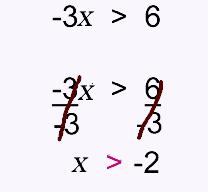 |
||||||||||||||||||||||
 |
||
If you take a look at the word itself, you can find a word within it that you DO know! Did you see it? Did you say, "equal?" You got it! Well, think to yourself, from your language arts class, what did you learn about the prefix in-? A-ha! So, 'inequalities' must mean 'not equal,' right? YAY! Back in elementary school, you learned all about inequalities. Say what? Yeah, you did! The only thing is, you called them Pacman or sharkmouth or alligator or some other silly name. Sheesh. Let's call them by their rightful names, please. Do you recognize these symbols? < and > or ≤ and ≥ If you do, then you are familiar with inequalities. See—easy stuff! Now, you simply need to understand HOW they are used in pre-algebra and algebra. |
||
Let's say you have something like this: x < 4 What are some of the possible values you could have for x? |
||||
The answers are infinite! The answers to an inequality are called the solution set. An easy way to show the answer is to graph the solution set as a number line. |
||
 |
||
Note how there is an open circle at the 4. This is because the value for x does not INCLUDE 4. What if you have something like: x ≥ -3 What would the solution set look like? Well, it would look like this! |
||
 |
||
Since the inequality symbol is a greater than OR equal to sign, the circle is colored IN. |
||
So, what would happen if you have an inequality sign in an equation? Hmm…let's think about this one! If you were to swap out the symbol for an equals sign, could you solve for the variable? Well, guess what…that's basically what you do with the inequality symbol, too! Let's try one. |
||
 |
||
Okay, go back and swap out that = for the original inequality symbol. x > 3 Voila! Now, you can graph your solution on the number line. |
||
 |
||
Uh oh…there IS one thing you have to know when you are working with inequalities and that is this one teensy-weensy weird thing. When you multiply or divide the inequality with a negative number you have to FLIP the sign over! That's right! You literally have to switch the sign the other way… Let's take a look at what this means. -3x > 6 Let's solve it like we normally do. |
||
 |
||
Go back and substitute some number that seems to 'fit' the inequality like 3. -3 • 3 > 6 -9 > 6 This is NOT true! EEK! So, this is why you have to FLIP the sign when you divide (or multiply) by a negative. x < -2 |
||
©2011–2017 Sherry Skipper Spurgeon. All rights reserved. |
||